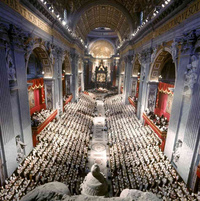
The Second Vatican Council (Latin: Concilium Oecumenicum Vaticanum Secundum, informally known as Vatican II) addressed relations between the Roman Catholic Church and the modern world. It was the twenty-first ecumenical council of the Catholic Church and the second to be held at Saint Peter's Basilica in the Vatican. The council, through the Holy See, formally opened under the pontificate of Pope John XXIII on 11 October 1962 and closed under Pope Paul VI on the Feast of the Immaculate Conception on 8th December 1965.
Several changes resulted from the council, including the renewal of consecrated life with a revised charism, ecumenical efforts towards dialogue with other religions, and the call to holiness for everyone including the laity, according to Pope Paul VI "the most characteristic and ultimate purpose of the teachings of the Council".
According to Pope Benedict XVI, the most important and essential message of the council is "the Paschal Mystery as the center of what it is to be Christian and therefore of the Christian life, the Christian year, the Christian seasons". Other changes which followed the council included the widespread use of vernacular languages in the Mass instead of Latin, the subtle disuse of ornate clerical regalia, the revision of Eucharistic prayers, the abbreviation of the liturgical calendar, the ability to celebrate the Mass versus populum (with the officiant facing the congregation), as well as ad orientem (facing the "East" and the Crucifix), and modern aesthetic changes encompassing contemporary Catholic liturgical music and artwork, many of which remain divisive among the Catholic faithful.




